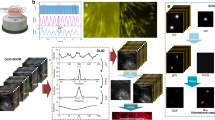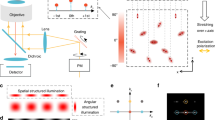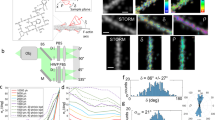Abstract
When excited with rotating linear polarized light, differently oriented fluorescent dyes emit periodic signals peaking at different times. We show that measurement of the average orientation of fluorescent dyes attached to rigid sample structures mapped to regularly defined (50 nm)2 image nanoareas can, in combination with application of the SPEED (sparsity penalty-enhanced estimation by demodulation) deconvolution algorithm, provide subdiffraction resolution (super resolution by polarization demodulation, SPoD). Because the polarization angle range for effective excitation of an oriented molecule is rather broad and unspecific, we narrowed this range by simultaneous irradiation with a second, de-excitation, beam possessing a polarization perpendicular to the excitation beam (excitation polarization angle narrowing, ExPAN). This shortened the periodic emission flashes, allowing better discrimination between molecules or nanoareas. Our method requires neither the generation of nanometric interference structures nor the use of switchable or blinking fluorescent probes. We applied the method to standard wide-field microscopy with camera detection and to two-photon scanning microscopy, imaging the fine structural details of neuronal spines.
This is a preview of subscription content, access via your institution
Access options
Subscribe to this journal
Receive 12 print issues and online access
$259.00 per year
only $21.58 per issue
Buy this article
- Purchase on Springer Link
- Instant access to full article PDF
Prices may be subject to local taxes which are calculated during checkout




Similar content being viewed by others
Change history
09 December 2015
In the version of this article initially published, it was not clearly indicated that all the results obtained required the use of the SPEED (sparsity penalty–enhanced estimation by demodulation) deconvolution algorithm to reconstruct dye orientation data. This has been amended as follows in all versions of the article. The sentence in the abstract that was previously "We show that measurement of the average orientation of fluorescent dyes attached to rigid sample structures mapped to regularly defined (50 nm)2 image nanoareas can provide subdiffraction resolution (super resolution by polarization demodulation, SPoD)" has been amended to "We show that measurement of the average orientation of fluorescent dyes attached to rigid sample structures mapped to regularly defined (50 nm)2 image nanoareas can, in combination with application of the SPEED (sparsity penalty–enhanced estimation by demodulation) deconvolution algorithm, provide subdiffraction resolution (super resolution by polarization demodulation, SPoD)." The sentence in the introduction that was formerly "This is done by rotating the polarization of a wide-field excitation beam and detecting the periodic signals emitted with different phases from different nanoareas using wide-field camera detection (SPoD)" has been amended to "This is done by rotating the polarization of a wide-field excitation beam and detecting the periodic signals emitted with different phases from different nanoareas using wide-field camera detection (SPoD), followed by reconstruction with a deconvolution algorithm, SPEED." Finally, the following sentence has been added to the introduction: "All images generated with SPoD and ExPAN in this paper include reconstruction with the SPEED algorithm".
References
Hell, S.W. Microscopy and its focal switch. Nat. Methods 6, 24–32 (2009).
Bates, M., Huang, B. & Zhuang, X. Super-resolution microscopy by nanoscale localization of photo-switchable fluorescent probes. Curr. Opin. Chem. Biol. 12, 505–514 (2008).
Lippincott-Schwartz, J. & Manley, S. Putting super-resolution fluorescence microscopy to work. Nat. Methods 6, 21–23 (2009).
Hell, S.W. & Wichmann, J. Breaking the diffraction resolution limit by stimulated emission: stimulated-emission-depletion fluorescence microscopy. Opt. Lett. 19, 780–782 (1994).
Betzig, E. et al. Imaging intracellular fluorescent proteins at nanometer resolution. Science 313, 1642–1645 (2006).
Hess, S.T., Girirajan, T.P.K. & Mason, M.D. Ultra-high resolution imaging by fluorescence photoactivation localization microscopy. Biophys. J. 91, 4258–4272 (2006).
Rust, M.J., Bates, M. & Zhuang, X. Sub-diffraction-limit imaging by stochastic optical reconstruction microscopy (STORM). Nat. Methods 3, 793–796 (2006).
Dertinger, T., Colyer, R., Iyer, G., Weiss, S. & Enderlein, J. Fast, background-free, 3D super-resolution optical fluctuation imaging (SOFI). Proc. Natl. Acad. Sci. USA 106, 22287–22292 (2009).
Chmyrov, A. et al. Nanoscopy with more than 100,000 'doughnuts'. Nat. Methods 10, 737–740 (2013).
Geisler, C. et al. Drift estimation for single marker switching based imaging schemes. Opt. Express 20, 7274–7289 (2012).
Hell, S.W. Toward fluorescence nanoscopy. Nat. Biotechnol. 21, 1347–1355 (2003).
Heintzmann, R., Jovin, T.M. & Cremer, C. Saturated patterned excitation microscopy—a concept for optical resolution improvement. J. Opt. Soc. Am. A Opt. Image Sci. Vis. 19, 1599–1609 (2002).
Gustafsson, M.G.L. Nonlinear structured-illumination microscopy: wide-field fluorescence imaging with theoretically unlimited resolution. Proc. Natl. Acad. Sci. USA 102, 13081–13086 (2005).
Marriott, G. et al. Optical lock-in detection imaging microscopy for contrast-enhanced imaging in living cells. Proc. Natl. Acad. Sci. USA 105, 17789–17794 (2008).
Richards, C.I., Hsiang, J.-C. & Dickson, R.M. Synchronously amplified fluorescence image recovery (SAFIRe). J. Phys. Chem. B 114, 660–665 (2010).
Lakowicz, J.R. Principles of Fluorescence Spectroscopy 2nd edn. (Kluwer/Plenum, 1999).
Walla, P.J. Modern Biophysical Chemistry: Detection and Analysis of Biomolecules (Wiley, 2009).
Vicidomini, G. et al. Sharper low-power STED nanoscopy by time gating. Nat. Methods 8, 571–573 (2011).
Mirzov, O. et al. Polarization portraits of single multichromophoric systems: visualizing conformation and energy transfer. Small 5, 1877–1888 (2009).
Thomsson, D., Lin, H. & Scheblykin, I.G. Correlation analysis of fluorescence intensity and fluorescence anisotropy fluctuations in single-molecule spectroscopy of conjugated polymers. ChemPhysChem 11, 897–904 (2010).
Hein, B., Willig, K.I. & Hell, S.W. Stimulated emission depletion (STED) nanoscopy of a fluorescent protein-labeled organelle inside a living cell. Proc. Natl. Acad. Sci. USA 105, 14271–14276 (2008).
Harris, K.M. & Kater, S.B. Dendritic spines: cellular specializations imparting both stability and flexibility to synaptic function. Annu. Rev. Neurosci. 17, 341–371 (1994).
Urban, N.T., Willig, K.I., Hell, S.W. & Nägerl, U.V. STED nanoscopy of actin dynamics in synapses deep inside living brain slices. Biophys. J. 101, 1277–1284 (2011).
Harris, K.M., Jensen, F.E. & Tsao, B. Three-dimensional structure of dendritic spines and synapses in rat hippocampus (CA1) at postnatal day 15 and adult ages: implications for the maturation of synaptic physiology and long-term potentiation. J. Neurosci. 12, 2685–2705 (1992).
Deller, T. et al. Synaptopodin-deficient mice lack a spine apparatus and show deficits in synaptic plasticity. Proc. Natl. Acad. Sci. USA 100, 10494–10499 (2003).
Izeddin, I. et al. Super-resolution dynamic imaging of dendritic spines using a low-affinity photoconvertible actin probe. PLoS ONE 6, e15611 (2011).
Richardson, W.H. Bayesian-based iterative method of image restoration. J. Opt. Soc. Am. 62, 55–59 (1972).
Lucy, L.B. An iterative technique for the rectification of observed distributions. Astron. J. 79, 745–749 (1974).
Vardi, Y., Shepp, L.A. & Kaufman, L. A statistical model for positron emission tomography. J. Am. Stat. Assoc. 80, 8–20 (1985).
Bertero, M. & Boccacci, P. Introduction to Inverse Problems in Imaging (Taylor & Francis, 1998).
Bissantz, N., Mair, B.A. & Munk, A. A statistical stopping rule for MLEM reconstructions in PET. in IEEE Nucl. Sci. Symp. Conf. Rec. 4198–4200 (IEEE, 2008).
Munk, A. & Pricop, M. in Statistical Modelling and Regression Structures (eds. Kneib, T. & Tutz, G.) 431–448 (Physica, 2010).
Testa, I. et al. Multicolor fluorescence nanoscopy in fixed and living cells by exciting conventional fluorophores with a single wavelength. Biophys. J. 99, 2686–2694 (2010).
Stoppini, L., Buchs, P.-A. & Muller, D. A simple method for organotypic cultures of nervous tissue. J. Neurosci. Methods 37, 173–182 (1991).
Edelstein, A., Amodaj, N., Hoover, K., Vale, R. & Stuurman, N. Curr. Protoc. Mol. Biol. 92, 14.20 (2010).
Acknowledgements
This work was financially supported by the Deutsche Forschungsgemeinschaft (DFG) (INST 188/334-1 FUGG). O.M.S. thanks the International Max Planck Research School (IMPRS) “Physics of Biological and Complex Systems” for financial support. T.A., A.M., C.S. and P.J.W. acknowledge support by DFG Collaborative Research Center (CRC) 755 and 803. M.Z. and M.K. acknowledge support by DFG grant KO 1674/5-1. A.M. acknowledges support by DFG and Schweizerischer Nationalfonds (SNF) grant FOR 916.
Author information
Authors and Affiliations
Contributions
N.H., M.G. and L.S.v.d.H. designed and performed experiments, analyzed data and wrote the paper; T.A. developed the statistical model and analytical tools, wrote the software package SPEED, analyzed data and wrote the paper; J.-H.C. performed experiments; M.Z., O.M.S., C.S. and M.K. provided samples and edited the manuscript.; A.M. developed the statistical model and analytical tools and edited the paper; and P.J.W. designed experiments, analyzed data and wrote the paper.
Corresponding author
Ethics declarations
Competing interests
The University of Braunschweig, with which N.H., L.S.v.d.H., M.Z., M.K. and P.J.W. are affiliated, has filed a patent for parts of this work.
Supplementary information
Supplementary Text and Figures
Supplementary Figures 1–4 and Supplementary Notes 1 and 2 (PDF 944 kb)
Supplementary Software
Algorithm to analyse SPoD data with exemplary raw data and necessary parameters. (ZIP 7131 kb)
Rights and permissions
About this article
Cite this article
Hafi, N., Grunwald, M., van den Heuvel, L. et al. Fluorescence nanoscopy by polarization modulation and polarization angle narrowing. Nat Methods 11, 579–584 (2014). https://doi.org/10.1038/nmeth.2919
Received:
Accepted:
Published:
Issue Date:
DOI: https://doi.org/10.1038/nmeth.2919
This article is cited by
-
Saturated confocal fluorescence microscopy with linear polarization modulation
Optical and Quantum Electronics (2023)
-
Fluorescence polarization modulation super-resolution imaging provides refined dynamics orientation processes in biological samples
Light: Science & Applications (2022)
-
Polarization modulation with optical lock-in detection reveals universal fluorescence anisotropy of subcellular structures in live cells
Light: Science & Applications (2022)
-
Polarisation optics for biomedical and clinical applications: a review
Light: Science & Applications (2021)
-
Selected tools to visualize membrane interactions
European Biophysics Journal (2021)



